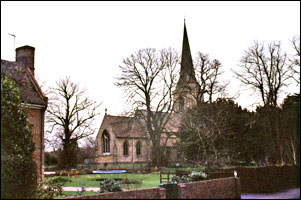![]()
The contents on this page remain on our website for informational purposes only.
Content on this page will not be reviewed or updated.
 |
|
 |
|
|
||||
|
Ridgmont - Nina Cecilia Bentinck
|
||||
|
||||
|
With the present interest in the forthcoming royal wedding, perhaps now is a good time to recall the ‘royal’ role of Ridgmont, as being the birthplace of Nina Cecilia Cavendish Bentinck, the mother of Prince William’s great grandmother, the late Queen Mother. The story begins with the Reverend Charles Cavendish Bentinck, a younger son of the 4th Duke of Portland, who, after a tragic first marriage to a Romany princess, married Caroline Louisa Burnaby, of Bedford, in 1850, the year following his appointment as the vicar of the parishes of Husborne Crawley and Ridgmont. Three daughters were duly born to the couple, and the Ridgmont registers record the baptism of Nina Cecilia, the eldest, on October 19th 1862. After the death of the Reverend Cavendish Bentinck in 1870 his widow married Henry Warren Scott, the third son of Sir William Scott of Ancrum, and the family would make their home at Forbes House, on the fringe of Ham Common, near Richmond. Being an officer in the Lifeguards, when not on duty at Windsor Castle, Claud George Bowes-Lyon, Lord Glamis, the son of the 13th Earl of Strathmore, would be a frequent visitor, and although the object of his affections would be Nina Cecilia, any thoughts of marriage were precluded by his army pay. Even when his grandmother died in January 1881 his financial prospects were not enhanced, for by a later codicil to her will she had amended the original inheritance - of estate valued at nearly £40,000, plus a house at St. Paul’s Walden Bury (which had passed to the Strathmores via their Bowes ancestors) - such that all of this now passed to Claud’s father for life. Thus Claud was left with only £400 a year, until his father allowed him not only the tenancy but also the income of St. Paul’s and the original annuity. With their finances now secure, Claud and Nina were married in July 1881, and shortly after their honeymoon Claud, with few regrets, left the army. At St. Paul’s Walden Bury the couple would now raise a large family, and as their ninth child, on Saturday August 4th 1900 Elizabeth Angela Marguerite was born at London. Yet apart from a canny old gypsy woman, few could know that this infant would successively become Duchess of York, Queen Consort and then Queen Mother. In due course, on the death of the 13th Earl in 1904 Claud and Nina became the Earl and Countess of Strathmore and Kinghorne, and their inheritance included not only the sum of £250,000 but also Glamis Castle, where during World War One Elizabeth and her mother would devote their attention to the care of wounded soldiers. However, when one of Elizabeth’s brothers, Fergus, was killed in action, Lady Strathmore fell seriously ill, and she would not fully recover until 1922. Matured by her wartime experience, Elizabeth now had little interest in the usual aristocratic pursuits, although it would be at a dance in 1920 that she made the acquaintance of ‘Bertie,’ Prince Albert. The story of their romance belongs elsewhere, but suffice to say that in the opinion of Lady Strathmore ‘she was torn between her longing to make Bertie happy and her reluctance to take on the responsibilities which this marriage must bring.’ But love duly triumphed, and when the drama of the Abdication propelled Bertie to the role of King, Elizabeth became his Queen. However, a few days before the Royal couple were to embark on a State Visit to France, Lady Strathmore suffered a heart attack, and died on June 23rd 1938. Her body was conveyed by the Royal Train to Scotland, and with the funeral being held at Glamis Castle, there she was interred in the private burial ground - the last resting place of Ridgmont’s most famous daughter.
|
||||
|
|
||||
|
|
||||


